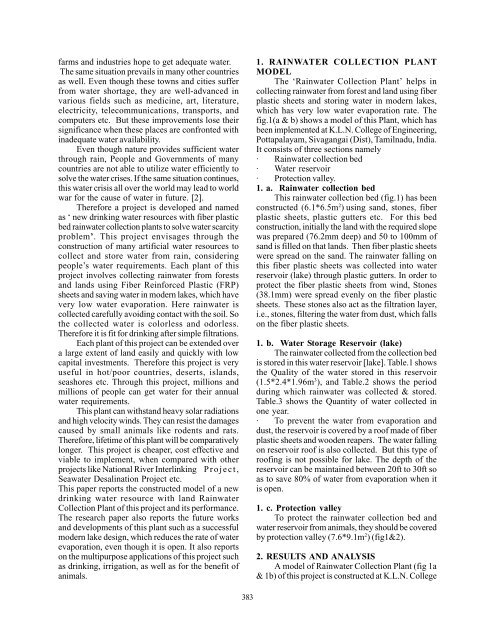Accepted Papers - 3.pdf - UNESCO
Accepted Papers - 3.pdf - UNESCO
Accepted Papers - 3.pdf - UNESCO
You also want an ePaper? Increase the reach of your titles
YUMPU automatically turns print PDFs into web optimized ePapers that Google loves.
farms and industries hope to get adequate water.<br />
The same situation prevails in many other countries<br />
as well. Even though these towns and cities suffer<br />
from water shortage, they are well-advanced in<br />
various fields such as medicine, art, literature,<br />
electricity, telecommunications, transports, and<br />
computers etc. But these improvements lose their<br />
significance when these places are confronted with<br />
inadequate water availability.<br />
Even though nature provides sufficient water<br />
through rain, People and Governments of many<br />
countries are not able to utilize water efficiently to<br />
solve the water crises. If the same situation continues,<br />
this water crisis all over the world may lead to world<br />
war for the cause of water in future. [2].<br />
Therefore a project is developed and named<br />
as ‘ new drinking water resources with fiber plastic<br />
bed rainwater collection plants to solve water scarcity<br />
problem’. This project envisages through the<br />
construction of many artificial water resources to<br />
collect and store water from rain, considering<br />
people’s water requirements. Each plant of this<br />
project involves collecting rainwater from forests<br />
and lands using Fiber Reinforced Plastic (FRP)<br />
sheets and saving water in modern lakes, which have<br />
very low water evaporation. Here rainwater is<br />
collected carefully avoiding contact with the soil. So<br />
the collected water is colorless and odorless.<br />
Therefore it is fit for drinking after simple filtrations.<br />
Each plant of this project can be extended over<br />
a large extent of land easily and quickly with low<br />
capital investments. Therefore this project is very<br />
useful in hot/poor countries, deserts, islands,<br />
seashores etc. Through this project, millions and<br />
millions of people can get water for their annual<br />
water requirements.<br />
This plant can withstand heavy solar radiations<br />
and high velocity winds. They can resist the damages<br />
caused by small animals like rodents and rats.<br />
Therefore, lifetime of this plant will be comparatively<br />
longer. This project is cheaper, cost effective and<br />
viable to implement, when compared with other<br />
projects like National River Interlinking Project,<br />
Seawater Desalination Project etc.<br />
This paper reports the constructed model of a new<br />
drinking water resource with land Rainwater<br />
Collection Plant of this project and its performance.<br />
The research paper also reports the future works<br />
and developments of this plant such as a successful<br />
modern lake design, which reduces the rate of water<br />
evaporation, even though it is open. It also reports<br />
on the multipurpose applications of this project such<br />
as drinking, irrigation, as well as for the benefit of<br />
animals.<br />
383<br />
1. RAINWATER COLLECTION PLANT<br />
MODEL<br />
The ‘Rainwater Collection Plant’ helps in<br />
collecting rainwater from forest and land using fiber<br />
plastic sheets and storing water in modern lakes,<br />
which has very low water evaporation rate. The<br />
fig.1(a & b) shows a model of this Plant, which has<br />
been implemented at K.L.N. College of Engineering,<br />
Pottapalayam, Sivagangai (Dist), Tamilnadu, India.<br />
It consists of three sections namely<br />
· Rainwater collection bed<br />
· Water reservoir<br />
· Protection valley.<br />
1. a. Rainwater collection bed<br />
This rainwater collection bed (fig.1) has been<br />
constructed (6.1*6.5m 2 ) using sand, stones, fiber<br />
plastic sheets, plastic gutters etc. For this bed<br />
construction, initially the land with the required slope<br />
was prepared (76.2mm deep) and 50 to 100mm of<br />
sand is filled on that lands. Then fiber plastic sheets<br />
were spread on the sand. The rainwater falling on<br />
this fiber plastic sheets was collected into water<br />
reservoir (lake) through plastic gutters. In order to<br />
protect the fiber plastic sheets from wind, Stones<br />
(38.1mm) were spread evenly on the fiber plastic<br />
sheets. These stones also act as the filtration layer,<br />
i.e., stones, filtering the water from dust, which falls<br />
on the fiber plastic sheets.<br />
1. b. Water Storage Reservoir (lake)<br />
The rainwater collected from the collection bed<br />
is stored in this water reservoir [lake]. Table.1 shows<br />
the Quality of the water stored in this reservoir<br />
(1.5*2.4*1.96m 3 ), and Table.2 shows the period<br />
during which rainwater was collected & stored.<br />
Table.3 shows the Quantity of water collected in<br />
one year.<br />
· To prevent the water from evaporation and<br />
dust, the reservoir is covered by a roof made of fiber<br />
plastic sheets and wooden reapers. The water falling<br />
on reservoir roof is also collected. But this type of<br />
roofing is not possible for lake. The depth of the<br />
reservoir can be maintained between 20ft to 30ft so<br />
as to save 80% of water from evaporation when it<br />
is open.<br />
1. c. Protection valley<br />
To protect the rainwater collection bed and<br />
water reservoir from animals, they should be covered<br />
by protection valley (7.6*9.1m 2 ) (fig1&2).<br />
2. RESULTS AND ANALYSIS<br />
A model of Rainwater Collection Plant (fig 1a<br />
& 1b) of this project is constructed at K.L.N. College

















